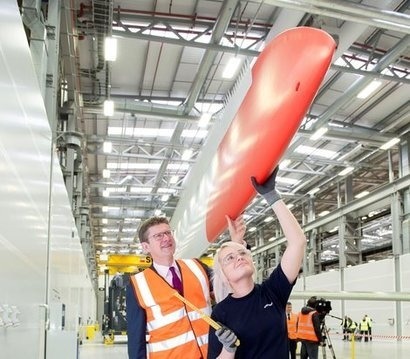
The blade was the first of hundreds to be manufactured in Hull every year for Siemens’ 7 MW and next-generation 8 MW turbines and will be among the first supplied to DONG Energy for the Race Bank wind farm off the Norfolk and Lincolnshire coast.
The milestone comes less than two years after a ground-breaking ceremony to mark the start of construction on a huge site the size of 78 football pitches at Hull’s Alexandra Dock. Since then, global offshore wind market leader Siemens and partner Associated British Ports (ABP) have transformed the under-utilised waterfront location into a world-scale hub for wind power manufacturing, logistics and assembly.
The development is one of Siemens’ largest-ever investments worldwide in manufacturing facilities. The factory has been delivered ahead of programme and within budget, with the new Hull workforce demonstrating rapidly their capability in world-class manufacturing and engineering.
As well as being given a tour of the new factory, guests saw 90-metre turbine towers which have been assembled at the dockside, ready for load out with other components early in January to the Dudgeon offshore wind farm off the Norfolk coast – the first project to be serviced by the new facilities in Hull. Dudgeon is joint venture owned by Statoil, Statkraft and Masdar.
“This is exactly the relationship we want to see between our large infrastructure projects in the UK and our supply chain companies as part of our industrial strategy” said Mr Clark. “Hull has established itself as an important manufacturing and engineering centre for this innovative and exciting new industry. In the coming years the new offshore wind projects that this factory will supply could generate enough clean electricity to power over three million homes and businesses – all with wind turbine blades produced by the dedicated and highly skilled Siemens workforce right here in Hull. Since 2010, there has been over £52bn of investment in renewables in the UK – creating thousands of highly skilled jobs and opportunities here in the UK to support our low-carbon economy.”
Siemens UK Chief Executive Juergen Maier added that the Hull factory is probably the best example of industrial strategy in action in the UK today – creating new, local, skilled jobs, sustainable growth and the latest renewable technology, benefitting the UK economy and society in general. Mr Maier believes that energy should be placed at the heart of UK industrial strategy, one of the greatest challenges being the need to increase productivity in the UK and generating growth while decarbonising the energy supply and reducing emissions in order to achieve a sustainable energy mix. He said that Siemens new wind turbine blade factory in Hull is an important part of the journey towards this objective and that it will be a catalyst for further significant investments by Siemens suppliers, customers and the industry at large. Most of all, the factory signals a positive future for manufacturing in the country.
Siemens announced it has employed almost 700 people in Hull so far, with 96 percent living within a 30-mile radius of the city, having received more than 23,000 job applications. A further 100 permanent staff are employed at Alexandra Dock working for Siemens’ suppliers and recruitment up to a total of 1,000 people will continue into 2017 as the site becomes fully operational. Hundreds more jobs have been created during construction and in the supply chain.
The Siemens factory and associated facilities are Hull’s largest-ever inward investment and at the forefront of an exciting wave of development as Hull prepares to be the UK City of Culture in 2017.
Development of the full Alexandra Dock site, including completion of a new harbour for pre-assembly and load out of wind turbine components, will continue into 2017.
For additional information:

